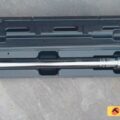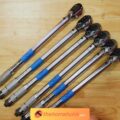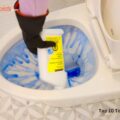Torque Wrenches are versatile tools that can be used by anyone looking to complete a project. These wrenches tighten nuts and bolts with extreme precision and quickness, and they don’t take a lot of time to master. They can be used on everyday items such as bicycles and car tires to more complex items such as aircrafts.
Although torque wrenches have many benefits, most people don’t know all of their advantages. They are thought to be fragile but are actually very durable. Requiring little maintenance, they can be used for years, if used correctly.
Table of Contents
What People Should Know About Torque Wrenches
There are three different styles of torque wrench that were made for a specific purpose: to measure and apply torque. After measuring torque, torque wrenches apply torque to fasteners in order to tighten them. They also have the ability to undo fasteners.
Maintaining torque wrenches can be done at home. Everything from calibration to unwinding the wrench and following the manufacturer’s written instructions preserves the life and accuracy of the wrench. There are 17 main tips that owners should know to better understand their torque wrenches.
1. Three Different Styles of Torque Wrenches Exist
The three different styles of torque wrenches are beam, clicker, and dial-type. Beam types use scales and pointers to indicate the amount of torque that is being applied. Clickers utilize a micrometer scale that is inside of the handle. The dial-type torque wrench is the most accurate and has a wide range of scales.
2. Torque Wrenches Have A Specific Purpose
There is no accurate way to measure bolt tension; however, there is a method of measuring twisting force, which is most often called torque. Measuring and applying torque is achieved through the use of torque wrenches, tools that apply precise amounts of torque to nuts and bolts.
3. Maintaining Torque Wrenches is Simple
Following instructions from the manufacturer is key to maintaining a safe, properly functioning torque wrench. Whether or not one is in the habit of lubricating his nuts and bolts, he should only do so if the manual instructs him to. Also, the user should stay within the torque wrench’s recommended working range, and if he notices any wear and tear on the wrench, he should replace the worn parts.
4. One Click is Enough
People sometimes allow torque wrenches to make multiple clicks. This isn’t ideal because it applies additional torque to the bolts. To receive the most effective results, one should use smooth, fluid movements when operating torque wrenches to better ensure that only one click is used.
5. Torque Wrenches Can Loosen or Undo Some Bolts
Loosening or undoing bolts are safe processes as long as the user is operating within the recommended working range of the torque wrench. However, if the user is at the maximum torque limit and the bolt has not yet loosened or been removed, another tool should be used to avoid exceeding the maximum torque limit and damaging the effectiveness of the torque wrench.
6. Modern, Digital Wrenches are More Accurate than Older Wrenches
This is an era of technology. Many things are digital, including torque wrenches. While old school, mechanical wrenches are very dependable, they are often times dependent on ball detent mechanisms or on flexible beams. Electronic wrenches are more independent, and their readings are 10 times more accurate than those of most mechanical wrenches.
7. Accurate Results Can be Achieved by Using Marked Loading Points
On the handles of most torque wrenches are marked loading points. To achieve the most accurate results, one should operate the torque wrench with his hand centered over the marked loading point. Noting the loading point is also necessary when calibrating the torque wrench.
8. There are Two Ways a Torque Wrench Can Be Calibrated
Those methods are Weight Calibration and Fish Scale Calibration. While Fish Scale Calibration requires more materials, it is the simpler method. Both methods require a bit of calculating and measuring.
9. Creating Extensions is Unsafe
Avoid using objects such as pipes to extend the length of the wrench handle. This is a poor method that can yield two setbacks: one can endanger himself, and the tool could become damaged, hindering its accuracy. If one finds that his wrench handle isn’t long enough, he should simply obtain a longer wrench.
10. Anyone Can Use a Torque Wrench
Torque wrenches aren’t only for highly skilled mechanics; anyone can effectively use this tool. This is because torque wrenches don’t require that the user exerts much energy and effort, and there is no physical strain involved. Torque wrenches also leave the bolts nice and tight, ensuring that the overall work is of high quality.
11. Using a Torque Wrench is Quick and Easy
Because torque wrenches deliver accurate results, users don’t have to worry about having to go over their work to re-tighten bolts. They can rest assured that the bolts are tightened to the manufacturer’s standards. Because they don’t rely on manpower, torque wrenches consistently tighten all nuts to the same point and are much faster and more efficient than traditional ratchets and wrenches.
12. Torque Wrenches Come Equipped with Adjustment Locks
Accidentally adjusting the wrench’s settings during use is a common problem. To avoid this mistake, apply the adjustment lock before operating the wrench. Doing so ensures that everything will go as planned and that the desired results will be achieved.
13. Dropped Doesn’t Mean Broken
Torque wrenches shouldn’t be thrown out simply because they hit the floor once or twice. While it is true that repeated falls have the potential to significantly damage the tool’s calibration, don’t assume that torque wrenches are broken simply because they have been dropped. Instead, send the tool to a shop to have it examined and, if necessary, re-calibrated.
14. People Get What They Pay For
Although it is widely known that torque wrenches give precise measurements, it is wise to conduct a bit of research to find the best torque wrench in which to invest. Some cheaper torque wrenches have to be replaced on a regular basis. Others offer easy calibration, interchangeable heads, and other benefits that some torque wrenches do not have.
15. Some Torque Wrenches Indicate in Only One Direction
Because a large number of torque wrenches are designed to only indicate clockwise, users should always read the wrench’s specification to ensure that it is compatible with the thread on which it is to be used. If one did not read the specification and were to use a clockwise wrench on an anti-clockwise thread, he could experience a loss of torque control.
16. Know the Pros and Cons of “Crow’s Foot” Fittings
Although the square drives of a torque wrench can be fitted with “crow’s foot” fittings, these fittings have the potential to change the tool’s torque. If one does decide to use a crow’s foot, however, he should do his research to find an appropriate offset that will ensure that the torque remains unaltered.
17. Wrenches Can Weaken from Lack of Use
If a person knows that he isn’t going to use his torque wrench for an extended amount of time, he should wind it back. Winding isn’t necessary if he is going to pull it back out and use it the next day, but if the wrench is not going to be utilized for a while, it should be winded to the minimum scale setting to prevent it from weakening and losing its accuracy over time.
Conclusion
The torque wrench is not a difficult tool to understand. When calibrated and handled properly, the wrench executes flawlessly. For uniform tightening of nuts and bolts, the torque wrench is an ideal tool.
Related Article:





